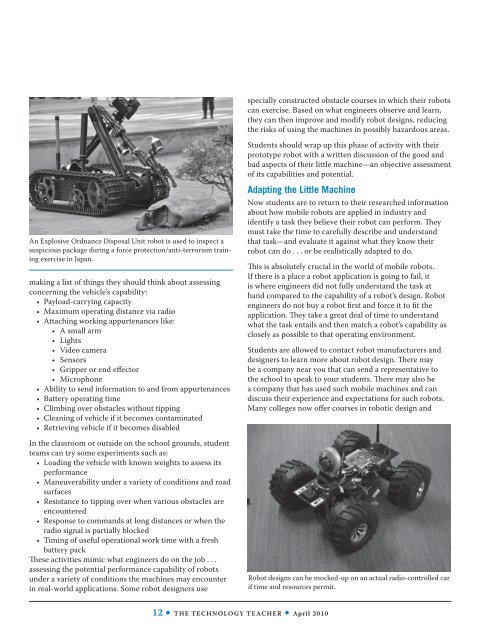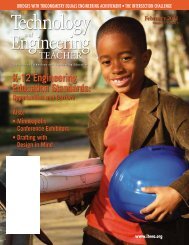Medical Technology: organ harvesting and Transplants
Medical Technology: organ harvesting and Transplants
Medical Technology: organ harvesting and Transplants
You also want an ePaper? Increase the reach of your titles
YUMPU automatically turns print PDFs into web optimized ePapers that Google loves.
specially constructed obstacle courses in which their robots<br />
can exercise. Based on what engineers observe <strong>and</strong> learn,<br />
they can then improve <strong>and</strong> modify robot designs, reducing<br />
the risks of using the machines in possibly hazardous areas.<br />
Students should wrap up this phase of activity with their<br />
prototype robot with a written discussion of the good <strong>and</strong><br />
bad aspects of their little machine—an objective assessment<br />
of its capabilities <strong>and</strong> potential.<br />
An Explosive Ordnance Disposal Unit robot is used to inspect a<br />
suspicious package during a force protection/anti-terrorism training<br />
exercise in Japan.<br />
making a list of things they should think about assessing<br />
concerning the vehicle’s capability:<br />
• Payload-carrying capacity<br />
• Maximum operating distance via radio<br />
• Attaching working appurtenances like:<br />
• A small arm<br />
• Lights<br />
• Video camera<br />
• Sensors<br />
• Gripper or end effector<br />
• Microphone<br />
• Ability to send information to <strong>and</strong> from appurtenances<br />
• Battery operating time<br />
• Climbing over obstacles without tipping<br />
• Cleaning of vehicle if it becomes contaminated<br />
• Retrieving vehicle if it becomes disabled<br />
In the classroom or outside on the school grounds, student<br />
teams can try some experiments such as:<br />
• Loading the vehicle with known weights to assess its<br />
performance<br />
• Maneuverability under a variety of conditions <strong>and</strong> road<br />
surfaces<br />
• Resistance to tipping over when various obstacles are<br />
encountered<br />
• Response to comm<strong>and</strong>s at long distances or when the<br />
radio signal is partially blocked<br />
• Timing of useful operational work time with a fresh<br />
battery pack<br />
These activities mimic what engineers do on the job . . .<br />
assessing the potential performance capability of robots<br />
under a variety of conditions the machines may encounter<br />
in real-world applications. Some robot designers use<br />
Adapting the Little Machine<br />
Now students are to return to their researched information<br />
about how mobile robots are applied in industry <strong>and</strong><br />
identify a task they believe their robot can perform. They<br />
must take the time to carefully describe <strong>and</strong> underst<strong>and</strong><br />
that task—<strong>and</strong> evaluate it against what they know their<br />
robot can do . . . or be realistically adapted to do.<br />
This is absolutely crucial in the world of mobile robots.<br />
If there is a place a robot application is going to fail, it<br />
is where engineers did not fully underst<strong>and</strong> the task at<br />
h<strong>and</strong> compared to the capability of a robot’s design. Robot<br />
engineers do not buy a robot first <strong>and</strong> force it to fit the<br />
application. They take a great deal of time to underst<strong>and</strong><br />
what the task entails <strong>and</strong> then match a robot’s capability as<br />
closely as possible to that operating environment.<br />
Students are allowed to contact robot manufacturers <strong>and</strong><br />
designers to learn more about robot design. There may<br />
be a company near you that can send a representative to<br />
the school to speak to your students. There may also be<br />
a company that has used such mobile machines <strong>and</strong> can<br />
discuss their experience <strong>and</strong> expectations for such robots.<br />
Many colleges now offer courses in robotic design <strong>and</strong><br />
Robot designs can be mocked-up on an actual radio-controlled car<br />
if time <strong>and</strong> resources permit.<br />
12 • The <strong>Technology</strong> Teacher • April 2010

















